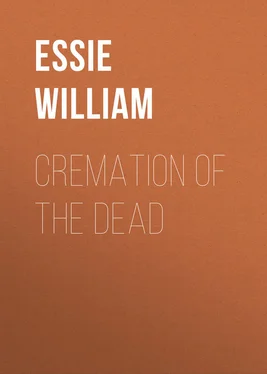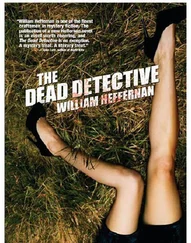William Essie - Cremation of the Dead
Здесь есть возможность читать онлайн «William Essie - Cremation of the Dead» — ознакомительный отрывок электронной книги совершенно бесплатно, а после прочтения отрывка купить полную версию. В некоторых случаях можно слушать аудио, скачать через торрент в формате fb2 и присутствует краткое содержание. Жанр: foreign_antique, foreign_prose, на английском языке. Описание произведения, (предисловие) а так же отзывы посетителей доступны на портале библиотеки ЛибКат.
- Название:Cremation of the Dead
- Автор:
- Жанр:
- Год:неизвестен
- ISBN:нет данных
- Рейтинг книги:4 / 5. Голосов: 1
-
Избранное:Добавить в избранное
- Отзывы:
-
Ваша оценка:
- 80
- 1
- 2
- 3
- 4
- 5
Cremation of the Dead: краткое содержание, описание и аннотация
Предлагаем к чтению аннотацию, описание, краткое содержание или предисловие (зависит от того, что написал сам автор книги «Cremation of the Dead»). Если вы не нашли необходимую информацию о книге — напишите в комментариях, мы постараемся отыскать её.
Cremation of the Dead — читать онлайн ознакомительный отрывок
Ниже представлен текст книги, разбитый по страницам. Система сохранения места последней прочитанной страницы, позволяет с удобством читать онлайн бесплатно книгу «Cremation of the Dead», без необходимости каждый раз заново искать на чём Вы остановились. Поставьте закладку, и сможете в любой момент перейти на страницу, на которой закончили чтение.
Интервал:
Закладка:
Were cremation practised now-a-days in times of warfare, and with our improved appliances, there would be no costly monuments to be kept up by the invaders, such as we now jealously maintain on the heights of Sebastopol 38 38 The commissioners sent to report upon the state of the English graveyards in the year 1872 found no less than 130 cemeteries occupied by our dead. Forty-five of them contained no monuments, and 65 only headstones of the commonest kind. The French had gathered together some 28,000 of their dead, and formed one large campo santo . The English commission reported that it would require 5,000 l. to put the graveyards in seemly order, and an annual expenditure of some 200 l. more. It appears that the graves have been frequently rifled by the Tartar peasantry in search of rings and other valuables. See 'Daily Telegraph,' Oct. 30, 1874.
– nothing be left behind to recall a strife best forgotten. The ashes of our warrior dead could even be brought home to lie in the fatherland. When Nestor recommended the bodies of the slain Achæans to be burnt close to the ships, in order that the survivors might be able to carry home the bones, and raise over them a common tomb, 39 39 'Iliad.'
he proved himself much wiser than our generation.
The general adverse feeling to burning even the dead bodies of animals at the present day, has without doubt often brought about serious evils. During the Crimean war the putrefaction of numberless horses in and around the French camps became ultimately a serious matter, 40 40 Dr. Parkes.
and had they been destroyed by fire no evil effects could have followed. Why were they not destroyed by fire? – for fear of offending the prejudices of their allies? For one reads that in the battle of Paris, on March 30, 1814, 4,000 horses which were killed, were burnt twelve days afterwards. It is doubtful, too, whether or not the removal of diseased cattle from our midst by burial only, is sufficient to stamp out a very virulent plague. I find that during the great plague of 1865, in Great Britain alone 132,000 cattle were attacked; 17,368 of which were killed, and 81,368 of which died. 41 41 Gamgee on the 'Cattle Plague.'
Had a few hecatombs been slain and burnt at the commencement of the visitation, or had the initial thousand of sickly ones been slain and consumed by fire in Russia, the steppe murrain would have been speedily stamped out.
In a similar manner should be treated the whole of the meat seized as unfit for food. In Gloucester, some years ago, and when the mayor had no power to fine the vendors of bad butchers' meat, the carcases were, it is said, destroyed by fire outside the city wall. Would that such jurisdiction existed now! In the metropolis alone, thousands of tons of animal food are yearly condemned, to say nothing of fruit and vegetables. The State should burn these up with even more alacrity than contraband of custom. And the purification by fire might be even extended to the humblest things. It has been said that the lower animals which perish in our midst must perforce send thousands of pounds of mephitic vapour daily into the air, if left unburnt. 42 42 Frazer.
It is not necessary to enumerate what else it would be desirable to destroy in this way. They can be seen in nearly every river, canal, and pond, in every ditch, gutter, and even street.
Medical men are the chief exponents of the good results which will follow the adoption of cremation, and with one exception the whole of the foreign writers upon the subject are professors of some branch of medical science. It is the same in our own country. 43 43 The last public utterance was made by Dr. Wheelhouse, of Leeds, in his address of October in the present year. He says: — 'Do we not shun, and that most wisely, the presence of those afflicted with infectious diseases so long as they remain amongst us; and yet, no sooner are they removed by death, than we are content, with tender sympathy indeed, and most loving care it is true (but with how much wisdom?), to lay them in the ground that they may slowly dissipate their terribly infectious gases through the soil, and saturating that, may thereby recharge the rains of heaven, as they filter through it, with all their virulence and terrible power of reproduction in the systems of the living. I am not the thorough and entire believer in the disinfecting and depurating power of the soil that I once was; for terrible examples of its failure have, in my judgment, come under my notice. 'Sir Henry Thompson has lately sounded a note of alarm on this subject; and though, for the present, it may fall upon ears unheeding or unsympathetic, I yet venture to think that, in time to come, his warning will be enforced by stern necessity, and that some better method of disposing of our dead will take the place of the burial so honoured and revered by us.'
CHAPTER II
METHODS OF TREATING THE DEAD
It will be necessary for my purpose to give a short description of the chief modes of disposing of the dead, and to quote a very few examples of each practice. In instancing such examples, I will as much as possible confine myself to my note-books of the last four years, and by so doing the matter will not only be more likely to possess novelty, but it will have been based upon the late observations of our distinguished travellers and possess authenticity.
The first method of disposal which I will mention is Exposure, which might be better described as no burial at all. The Colchians and Phrygians at one time hung the dead bodies upon the limbs of trees, 44 44 Frazer.
and some of the Indians of the Plains of North America to the present day do little else, since they expose their dead, after a rude bandaging, upon platforms erected upon the top of tall poles. Many ancient nations, however, purposely exposed their dead to the predatory instinct of animals. For instance, the Syrcanians abandoned their dead to wild dogs. 45 45 Spondanus.
The ancient Ethiopians threw their dead into the water, to be devoured by aquatic animals. 46 46 Frazer.
The Parsees, as far back as 400 B.C., and for an untraced time previously, exposed their deceased friends upon high gratings to feed birds of prey, and such 'towers of silence' are in use up to the present day. Dr. Aveling informs me that in India they are accustomed to carry the body to the top of a hill and place it upon a stone slab, returning for it in order to bury it when the bones are picked clean. Disturbances have frequently taken place of late between the Hindoos and Parsees owing to this practice, for the vultures and other birds often let fall portions of the body during their flight into the gardens of the former. And speaking still of our own times, the Hindoos often expose their dead by the banks of their sacred river to the attacks of the river monsters; some of them even, when fuel is scarce, cast the partly burnt body into the Hooghly. Some Kaffir tribes also remove the dead out of sight to spots in the bush, where they are devoured by wild beasts. 47 47 'Iron.'
Casting the body into the deep is another form of exposure, with the reservation that although it is understood to be in the nature of things that it will be devoured by the lower animals, this is not the primary motive. The practice is common with all maritime nations on the occurrence of deaths out at sea. Burial in the sea generally has, however, of late been recommended as a panacea for the ills seen to be consequent upon inhumation. One writer 48 48 Veritz.
pictures the 'dead ship' daily departing from the strand with its lifeless burden, and reverently and prayerfully committing the bodies to the bosom of the 'mystic main,' until the time when the sea shall give up its dead. But there is little to recommend the practice, even if the idea were not revolting to a people who exist largely upon fish and crustaceans. When a flight of locusts was some years ago swept by a storm into the Bay of Smyrna, many people there would not feed upon fish for a considerable time afterwards, and what would the feeling be if only the dwellers in our littoral towns and villages followed out burial in the sea? Even the sinking of the bodies with heavy weights down to the ocean's depths would be hazardous. The only people who appear to practise sea-burial are the aborigines of the Chatham Islands. When a fisherman there departs this life, they put a baited rod in his hand, and, after lashing him fast in a boat, send him adrift to sea. 49 49 Welch and Davis.
But I need not further continue the subject, 50 50 Dr. Parkes, in the chapter upon the Disposal of the Dead , in 'Practical Hygiene,' evidently leans to the opinion that burial in the sea might suit maritime nations.
and I think that it may be taken for granted, that sea-burial, or immarment, or immersion, or aquation, or whatever names the method may be known by, will never become general. The ancient Lacustrine dwellers did not practise water-burial, but disposed of their dead upon terra firma , evidently from motives that have already been explained.
Интервал:
Закладка:
Похожие книги на «Cremation of the Dead»
Представляем Вашему вниманию похожие книги на «Cremation of the Dead» списком для выбора. Мы отобрали схожую по названию и смыслу литературу в надежде предоставить читателям больше вариантов отыскать новые, интересные, ещё непрочитанные произведения.
Обсуждение, отзывы о книге «Cremation of the Dead» и просто собственные мнения читателей. Оставьте ваши комментарии, напишите, что Вы думаете о произведении, его смысле или главных героях. Укажите что конкретно понравилось, а что нет, и почему Вы так считаете.












